Guinea pigs are often thought of as short-lived pets. However, while their lifespan can be as short as 4 years, some have lived up to 10 years (Minarikova et al, 2015). This is not so short lived considering some large breeds of dogs, such as mastiffs, have an average lifespan of 8 years (Bell and Hesketh, 2021). As owner education improves and veterinary medicine advances, with more practices able to offer exotic pet care, it is likely that these species will continue to live into older age.
Older dogs and cats are often seen in practice for ongoing care. However, fewer older small pets are seen because of their short lives and less demand for veterinary care in these species. This may also be the result of a lack of obvious clinical signs in these animals. For example, in dogs that have osteoarthritis, owners will describe their pet showing lameness, stiffness and a change in gait (Belshaw et al, 2020), whereas in prey species such as rabbits, signs of pain and discomfort are likely to be subtle and some owners may not pick these signs up (Malik, 2021). It is vital when seeing these pets in practice to discuss the full history, home care and behaviours with owners to establish any signs of pain or behavioural changes.
Older guinea pigs can experience a number of issues. This article will look at each of these separately to consider what care can be given to ensure they have a better welfare.
Osteoarthritis
Arthritis is often seen in guinea pigs that are suffering from hypovitaminosis C (scurvy) as this results in intra-articular haemorrhage (Witkowska et al, 2017). It has also been noted in those infected with Streptococcus pneumoniae alongside scurvy (Witt, 1988). Spontaneous development of arthritis has been noted in laboratory guinea pigs (Wei et al, 1998).
In the author's experience, the majority of older guinea pigs that are presented and have radiographic imaging are experiencing stifle degenerative changes (Figure 1) and in some cases shoulder and elbow changes. Therefore, it could be assumed that a large proportion of older guinea pigs are likely to be suffering from degenerative joint disease. In humans, obesity is a primary risk factor for osteoarthritis (Guilak, 2011), and it is one of several factors leading to canine arthritis (Anderson et al, 2020). Therefore, it is likely that overweight guinea pigs are at a higher risk of developing joint disease in later life. Other factors such as hypovitaminosis C, infections, renal insufficiency and general body conformation should also be considered.
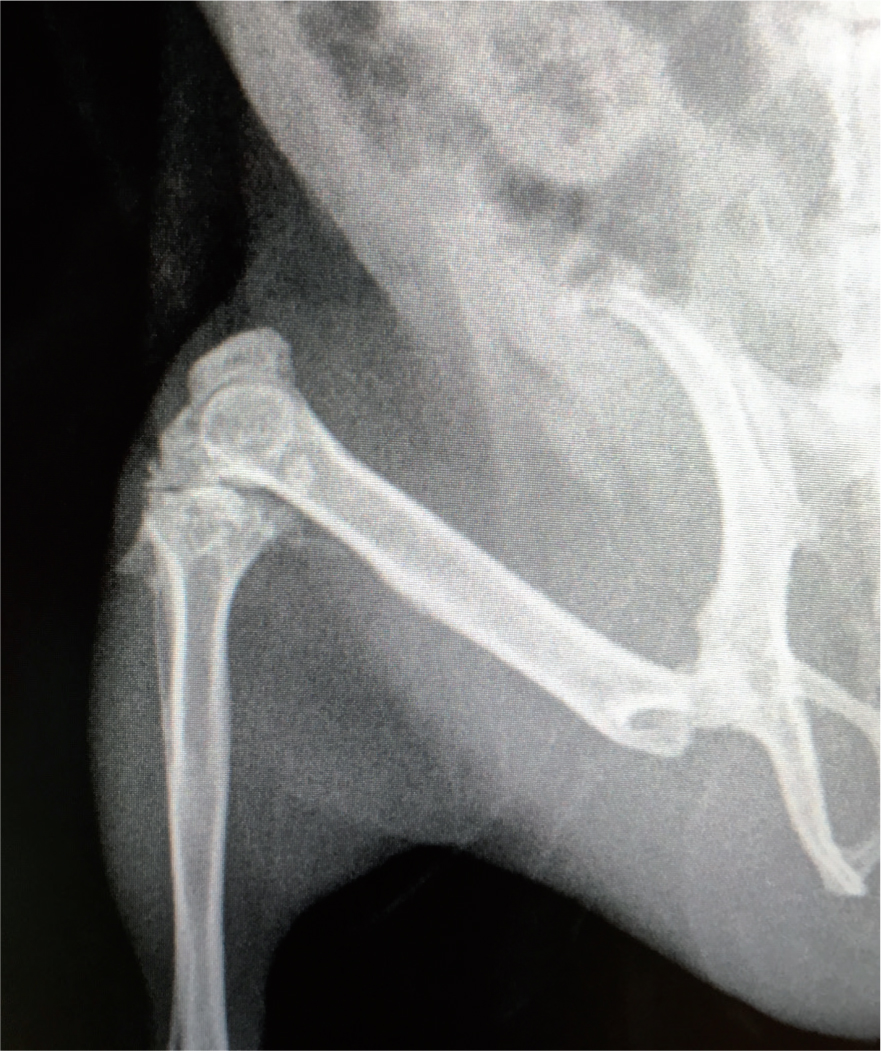
Guinea pigs with arthritis are unlikely to show consistent clinical signs as they are a prey species – prey animals hide signs of pain and illness to avoid the risk of predation. It is likely to be difficult for many owners to pick up signs of joint pain in these animals and in many cases they are diagnosed coincidently on radiographic imaging. Signs that the author considers notable include:
- Reluctance to move as much as they used to
- Reluctance or inability to jump, reach stand on hindlimbs or climb onto steps/up ramps
- Wobbly or shifting gait when ambulating or standing and hindlimb hopping type behaviour (not during displays of happiness, known as popcorning)
- Secondary pododermatitis from immobility
- Palpable thickening of the stifle joint(s)
- Difficulty chewing if the temporomandibular joint is affected.
If osteoarthritis is affecting the temporomandibular joint, the guinea pig is likely to need its food cut up into smaller portions and may also require ongoing corrective dental burring. Arthritis of the temporomandibular joint can be diagnosed by a rostro-caudal skull radiograph or computed tomography scan.
Arthritis should be treated as it is in other species, including appropriate analgesia such as meloxicam and gabapentin at adequate doses and timings. A weight loss plan should be initiated if appropriate. This can be achieved by restricting pellets and fresh foods and feeding with a mostly hay-based diet. Care should be taken that there is adequate vitamin C in the diet when less fresh vegetables are being fed. Supplementation may be necessary in these cases. Maintenance doses of vitamin C for guinea pigs should be 10–20 mg/kg/day (Grant, 2014), although higher doses have been suggested, especially during times of illness and pregnancy. Joint supplementation with Oxbow Natural Science Joint Support Supplement (Oxbow Animal Health, USA) or similar may also be beneficial for these animals. This contains plant-based glucosamine, which is a supplement that may be beneficial to joint cartilage structure.
Adjunctive therapies, such as acupuncture or physiotherapy, may be considered in patients with arthritis. The author has seen positive results from acupuncture in her own guinea pigs (Figure 2).
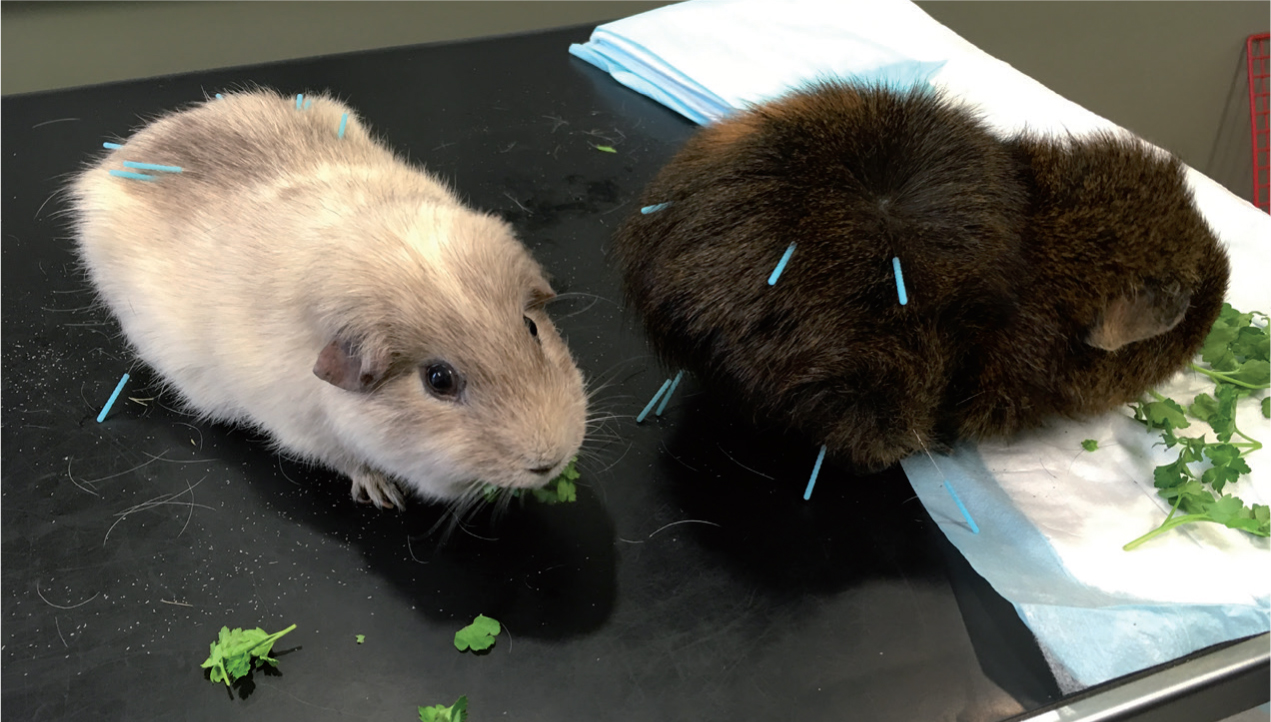
Guinea pigs with joint pain are also less likely to be able to groom and move as well as usual. They will often require more care at home, such as regular grooming and in some cases bathing, because they are unable to stance to urinate properly or move away from soiled bedding immediately. As with rabbits, a guinea pig with a soiled perineum will be at a higher risk of developing myiasis (fly strike) as flies will be attracted to lay in ammonia-rich compounds such as urine and faeces (Cousquer, 2006). Bedding should always be kept as clean as possible, especially during warmer months.
Pododermatitis
Pododermatitis is often called bumblefoot and is the presence of sores on the base of the feet. This can range from mild erythema to deep ulceration and osteomyelitis. Ischaemia and necrosis of the tissues as a result of pressure and then chronic inflammation leads to hyperkeratosis of the skin and ulceration (Figure 3). Poor perfusion from inflammation is common, as well as secondary infections spreading from wounds and systemic infection. The most common causative infectious agent of this disease in guinea pigs is Staphylococcus aureus (Brown and Donnelly, 2008). In rabbits the sores can be graded from 1–6 depending on the severity, 1 being mild changes to 6 being loss of pedal function (Mancinelli et al, 2014). Initial causes of this disease include inactivity as a result of pain or illness, inappropriate flooring or substrate, and obesity.
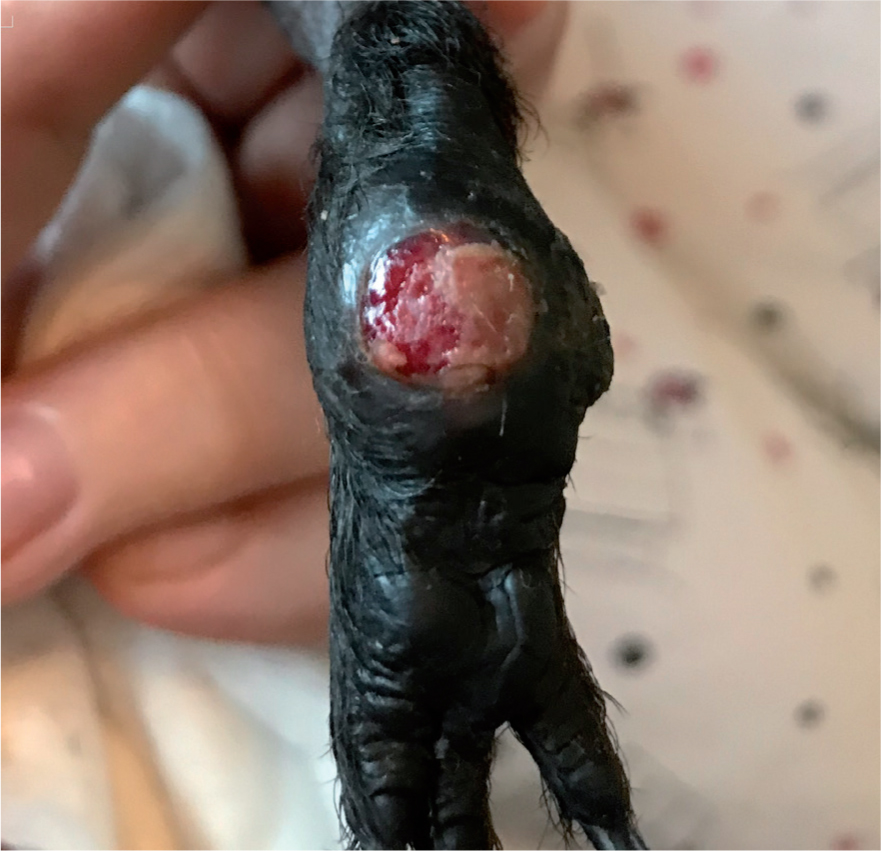
Prevention includes ensuring that guinea pigs are kept clean when unwell or longer haired, and that bedding is not abrasive. Pine and cedar bedding should be avoided as these can cause contact dermatitis (Hoppmann and Barron, 2007). Keeping the claws trimmed will also reduce pressure on the pad as an increased length will rotate the foot backwards onto the hock area. It is important to ensure that the animal is not overweight and that any underlying pain is addressed to reduce periods of inactivity.
Renal disease
Kidney disease in older guinea pigs is probably far more common than many veterinarians realise. It is hard to diagnose and, in the author's experience, biochemical and haematological blood changes do not correlate with the level of disease that these animals experience – many have little or no changes to their values at all. Weight loss, polydipsia or polyuria, or urine scald can all be signs of potential renal failure in these animals (Jenkins, 2010). Renal disease may also contribute to the development of dental disease by causing secondary renal hyperparathyroidism; this leads to osteodystrophy of the mandible which causes dental overgrowth. Although renal failure is seen in all breeds of guinea pig, it is particularly recognised in those with a satin coat (Stoffels-Adamowicz, 2014). As with other species, the only treatment for this disease is palliative. The use of telmisartan (Semintra, Boehringer-ingelheim, Germany) or Benazepril (Fortekor, Elanco UK AH Limited, UK) may be beneficial in reducing the excess loss of protein in the urine and reduce the incidence of hypertension which is often seen as a secondary problem in feline patients with kidney disease. Neither of these drugs are curative for kidney disease but can help slow the progression of the disease.
Neoplasia and reproductive disease
Although neoplasia is reported in guinea pigs, malignant cancers are rare in these species (Jelínek, 2003). The most common cutaneous neoplasms in these species are trichofolliculomas (33% of all cutaneous neoplasms) and lipomas (25.5%). Malignant tumours are much less common, at around 3% for soft tissue sarcomas (Kanfer and Reavill, 2013).
Other notable forms of neoplasia in guinea pigs include lymphoma and thyroid adenomas and carcinomas, which often go undiagnosed in many animals. The median age of guinea pigs with hyperthyroidism is 5 years (Girod-Rüffer et al, 2019). Both male and female guinea pigs develop malignant and benign mammary tumours, but these have only been reported in about 1.3% of guinea pigs seen in exotics clinics (Kondert and Mayer, 2017).
Female guinea pigs can develop cystic ovaries, with 66–75% of sows developing this condition (Pilny, 2014). These are most commonly rete cysts with a prevalence of 58–100% in some studies. Follicular cysts are less common at around 22.4% (Bean, 2013). Unfortunately the former, more common cyst does not usually respond to hormone therapies, so the majority of cystic ovaries in guinea pigs can only be cured by ovariohysterectomy. Older guinea pigs, especially those suffering from other conditions, may not be appropriate candidates for anaesthesia so some of these patients may need to be managed palliatively. This may include analgesia and in some cases percutaneous draining of particularly large cysts. Pyometra has been reported in guinea pigs as well as uterine tumours, most commonly leiomyomas (Bertram et al, 2018).
Home care and owner education
Ensuring that owners are educated on the best ways to care for their elderly guinea pig is vital for the ongoing welfare of these animals and veterinary nurses can have an important impact in this area. Regular health checks will help diagnose any underlying disease and educate the owner on the care of their pet. As well as treating any underlying conditions and providing analgesia the author advises the following for older guinea pigs.
Enclosures
Older guinea pigs should not be housed outside in the UK, especially during winter months as this will predispose them to immunosuppression and hypothermia. An ideal environmental temperature for this species is 18–24°C. Enclosures should ideally be on one level with no areas accessed by steps/ledges. If the enclosure has a second level, then a shallow ramp with protected edges should be provided to prevent falls.
Guinea pigs with mobility issues should have all food and resources available on the main floor to ensure that they do not need to use the ramp if this is painful. Substrate should be soft and absorbable, deep hay, vetbed or paper-based bedding work well for poorly mobile guinea pigs. Owners should be diligent with cleaning to reduce the incidence of pododermatitis. Providing guinea pigs with ultraviolet B radiation lighting may be advantageous (Figure 4), especially for those with renal insufficiency, as it significantly increases the circulating levels of 25-hydroxyvitamin D3 (Watson et al, 2014).
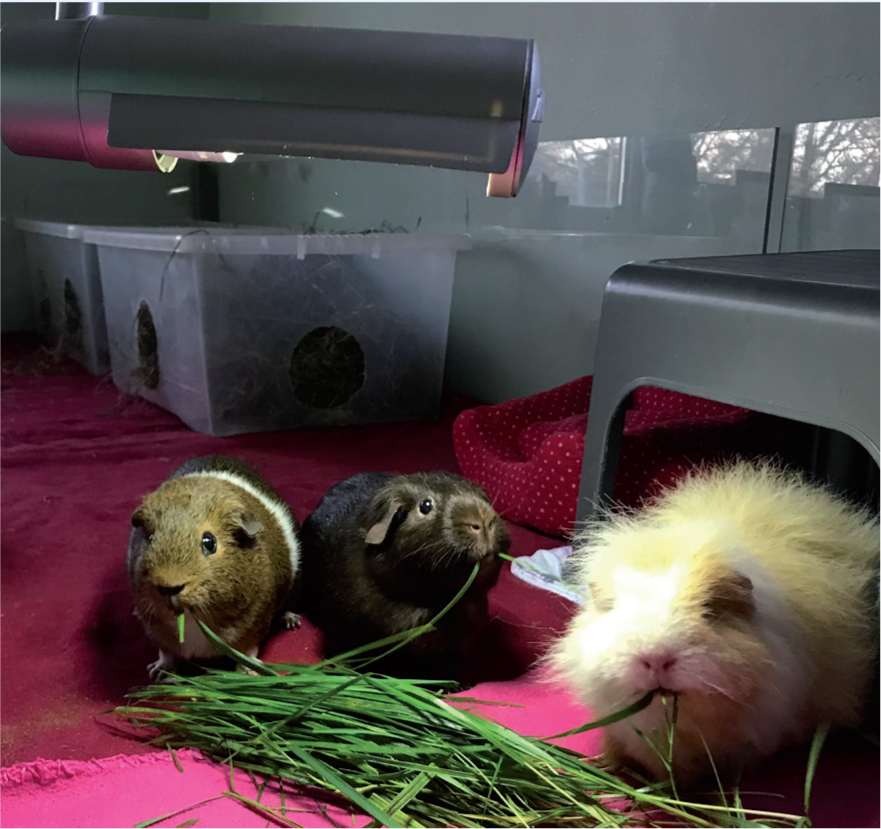
Companionship
All older guinea pigs should have the companionship of another guinea pig. Rescue centres can provide bonding services for bereaved individuals. Owners not wishing to keep guinea pigs any longer may be able to discuss with rescue centres about rehoming their elderly lone guinea pig or fostering a companion.
Hygiene and preventive care
Owners should monitor their pet's hygiene and provide them with grooming, bathing and hair clipping as needed, especially in long-haired individuals (Figure 5). Nails should be regularly clipped to an appropriate length (Figure 6). Older unneutered boars often require evacuation of excess faecal matter around the perianal sac as a result of stretching of the muscles around the area (Fawcett, 2011). Owners may need to do this every day in severe cases. Guinea pigs should be regularly weighed at home, as this will help owners pick up signs of illness at an early stage.
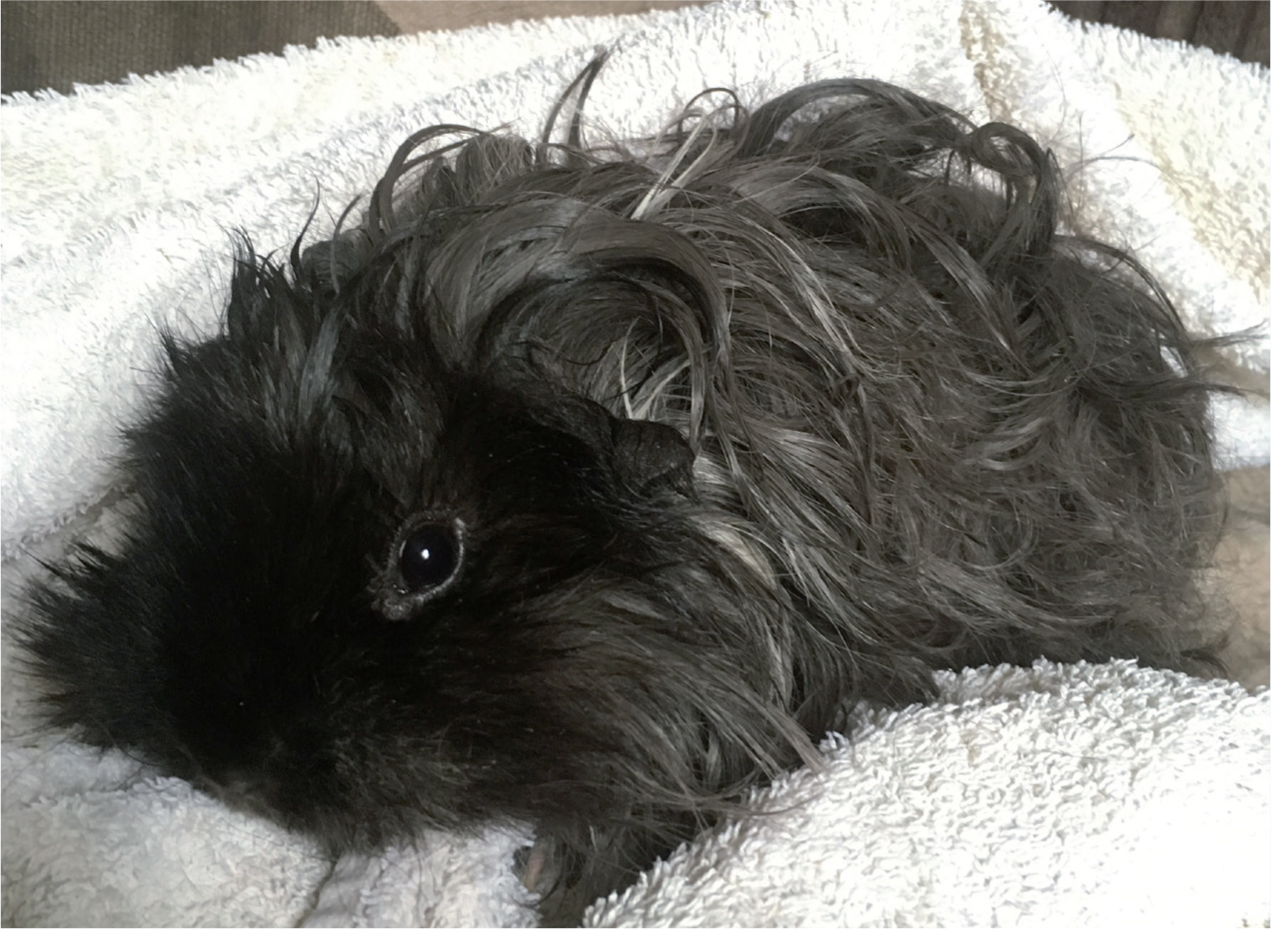
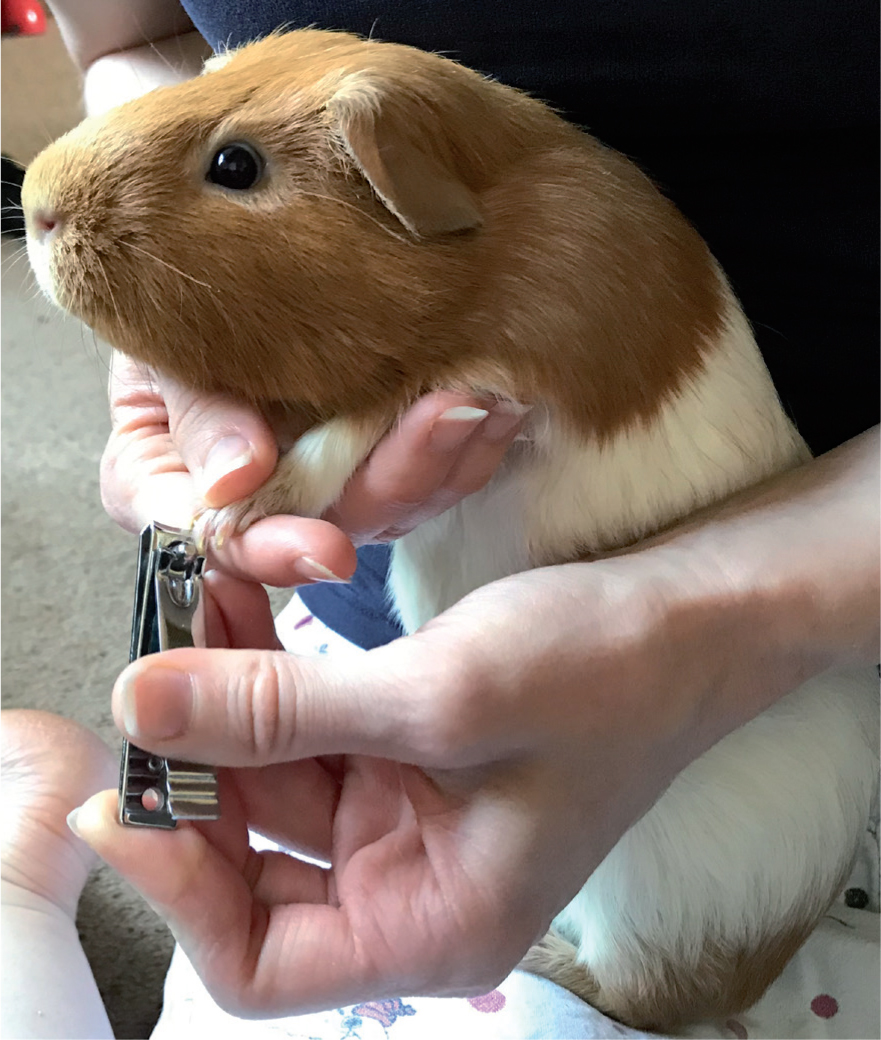
Increasing calories
Guinea pigs that are underweight, such as those with renal disease, will benefit from increased calories within the diet. Attempts to increase the weight may be done by feeding the following:
- Syringe feeding EmerAid Herbivore (a higher calorie food)
- Cereal hays (eg oat, rye), as these are higher in calories
- Fresh grass or ready grass
- Higher calorie fresh food occasionally (eg carrot), although care should be taken not to overfeed these foods
- Junior guinea pig pellets (although these have a higher protein level which may be detrimental to kidney health).
End-of-life care
As a prey species, it can be hard to assess a guinea pig's level of discomfort and quality of life as many will hide signs of pain. End-of-life care should be discussed with owners at an early stage of palliative care. This prepares the owner for the time of euthanasia and care afterwards, including post mortem examination where appropriate. Discussions on home burial and cremation should take place where the owner is receptive. In some cases the owners may wish to choose their own cremation service or drop their pet off for cremation themselves; this should be given as an option (Figure 7).
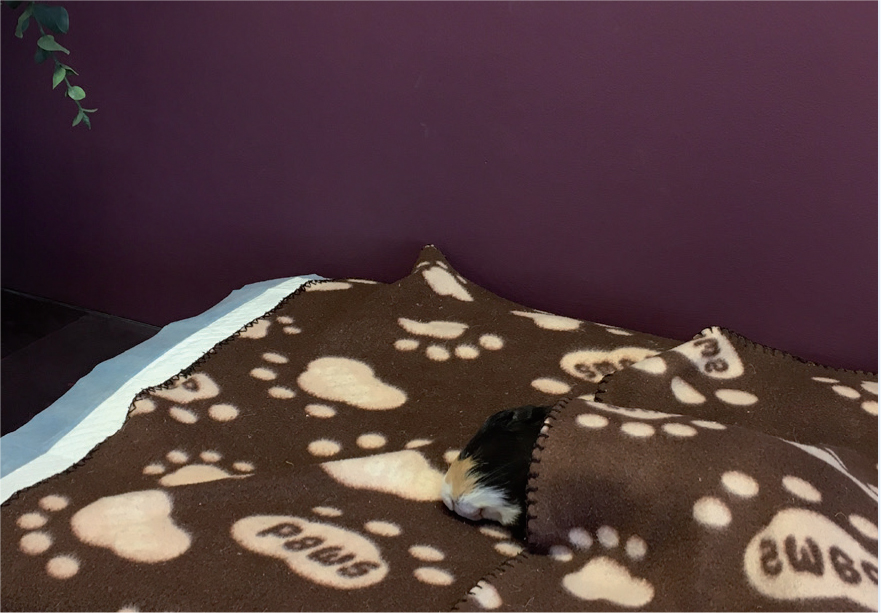
In many cases the owners will be unable to be present for the final injection of pentobarbitone as commonly these species are given volatile anaesthesia followed by an intracardiac injection. This should be discussed to ensure that owners understand why this is necessary. However, alternative pain-free methods could be used where an owner is particularly bonded, such as using high levels of injectable sedative agents so that the owner can hold their pet while they fall asleep. All owners and pets should be treated on an individual basis to ensure that their needs and grief are dealt with sympathetically and sensitively.
Conclusions
Guinea pigs scan experience a number of conditions in older age and owners should remain diligent in caring for their pets to help pick these diseases up at an early stage. Regular weighing can help with this. Yearly or 6-monthly veterinarian or nurse checks can also be advantageous and staff should always ask owners about husbandry, feeding and behaviour at home to help pick up on illness. Guinea pigs often suffer from mobility problems in older age so will benefit from long-term analgesia and care with grooming and bathing. Changes to enclosures and soft absorbent substrate should be initiated as this will help reduce the incidence of bumblefoot. Owners should be guided in assessing their pet's quality of life and discussions about end of life are better held as early as possible to ensure that owners are prepared.
KEY POINTS
- Guinea pigs can live as long as 10 years in some cases, older ages are likely to be seen more commonly as exotic pet medicine becomes more accessible.
- Arthritis is commonly seen in older guinea pigs and can be attributed to hypovitaminosis C. Treatment involves long-term analgesia.
- Pododermatitis is common in the older guinea pig, often seen secondary to other conditions.
- Renal disease is fairly common in guinea pigs but hard to definitively diagnose; treatment for this condition is palliative.
- Discussions about end-of-life care and quality of life should be made with owners where possible to ensure that the welfare of the guinea pig is monitored and owners are more prepared for end-of-life decisions.


